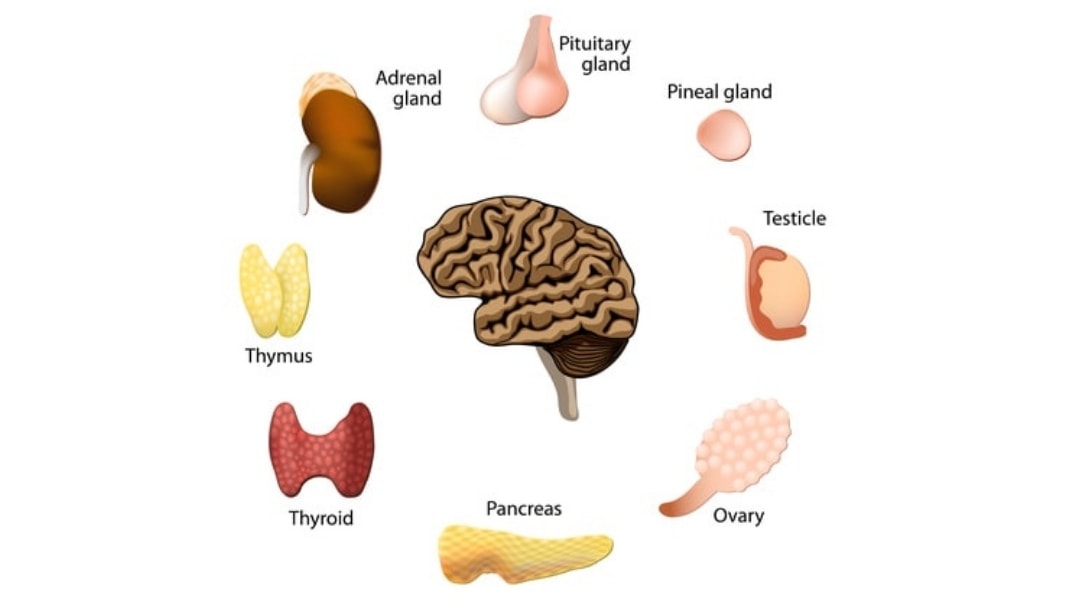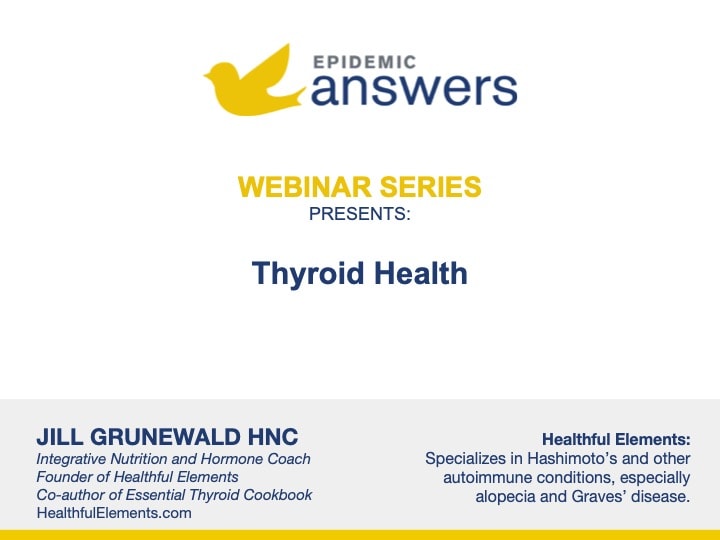Excerpted from Resistance to Thyroid Hormone: Implications for Neurodevelopmental Research on the Effects of Thyroid Hormone Disrupters by Peter Hauser, J. Michael McMillin, and Vinod S. Bhatara, and from personal communication with Audrey McMahon.
Thyroid Hormone and Neurodevelopment
Thyroid dysfunction and autism, ADHD, SPD and other developmental delays is common.
The effects of thyroid hormone on the growing brain and on later cognitive functioning are well-documented. It is clear that thyroid hormone is essential to normal behavioral and intellectual development. Thyroid hormone influences the development of synapses, dendrites and myelination of the central nervous system (CNS).
Doctors know that congenital hypothyroidism (low thyroid), if not treated, can result in mental retardation. They are only now recognizing, however, that mild to moderate impairment of thyroid function in a pregnant mother may adversely affect brain development, as well as cause subtle to severe intellectual and behavioral abnormalities, such as learning disabilities, attention deficits and possibly certain pervasive developmental disorders such as autism.
Precise amounts of the hormone appear to be of vital importance for CNS development during three critical periods.
- In phase 1 (conception to 12 weeks) the source of thyroid hormones is maternal and is transported through the placenta. If the supply is insufficient, the brainstem and brain development are affected.
- In phase 2 (12 to 40 weeks gestation), neurodevelopment is influenced by both maternal and fetal thyroid hormone. It is during this exquisitely sensitive period that nerves and their dendrites and synapses form. Even the smallest degree of insufficiency could cause subtle problems.
- During phase 3 (birth to 2 years), the child’s own thyroid gland takes over, as the CNS matures.
Endocrine Disruptors
Complicating this scenario is increasing evidence that exposure to environmental toxins can impair normal thyroid function. Certain synthetic compounds including polychlorinated biphenyls (PCBs), dioxins and dioxin-like compounds (DLCs) have been proven to be damaging. These types of compounds are known as endocrine disruptors.
It is well-documented in both Japan and Taiwan that exposing children to these toxins during critical developmental stages impairs learning, memory and attention. Other studies suggest that exposing pregnant mothers to these synthetic chemicals during pregnancy may adversely affect their offspring’s intelligence and behavior.
While some neurodevelopmental effects are temporary, others persist into adulthood. Reported long-term effects include impairment of cognitive functioning, altered neuromotor and sexual behavior, and reduced thyroid hormone levels.
A Parent’s Experience
A parent who learned about thyroid first hand is Audrey McMahon, a founder of the Learning Disabilities Association (LDA) and the past chairperson of its Research Committee. She knew something was wrong with her son, born in 1951, long before a great deal was known about developmental problems.
Audrey had been taking thyroid supplements on and off, according to medical direction, since the age of 13. After researching her family’s history, Audrey deduced that her brother’s delays were related to her mother’s hypothyroidism, and that her great uncle was also probably affected. Her son is thus the third generation of offspring from a family of women with underactive thyroids.
McMahon’s indefatigable search for answers finally led to the diagnosis of her son’s Asperger’s syndrome in the early ’80s. She discovered that this syndrome had only been recognized in Europe, and not yet in the USA.
She was later instrumental in the inclusion of Asperger’s syndrome as a classification in the DSM-IV. However, this did not take place until 1994!
In 1995, she arranged a pre-conference symposium for the LDA on “Thyroid Function and Learning Disabilities.” Speakers included Drs. Hauser, Patricia Rodier, Reed Larsen and Joanne Rovet.
Audrey’s family and others were part of a research study. Strong evidence suggests that hypothyroidism plays an important role in the birth of their first-born sons with delays.
Research is expanding on finding markers for Asperger’s and other developmental disorders. A few years ago, the American Thyroid Association had only a handful of researchers interested in pre-natal brain development.
Thyroid Testing Before Conception
We are making progress to learn about the thyroid/neurodevelopment correction, but many of tomorrow’s offspring are still at risk. It is important for a woman to have her thyroid tested at least six months before getting pregnant. Make sure that levels are well into the normal range, and establish therapy, if needed, prior to conception.
“An ounce of prevention is worth a pound of cure.”
Still Looking for Answers?
Visit the Epidemic Answers Practitioner Directory to find a practitioner near you.
Join us inside our online membership community for parents, Healing Together, where you’ll find even more healing resources, expert guidance, and a community to support you every step of your child’s healing journey.
Sources & References
Adams, J.B., et al. Mercury in first-cut baby hair of children with autism versus typically-developing children. Toxicological & Environmental Chemistry. 2007 Jun;70(12):1046-51.
Adams, J.B., et al. Mercury, Lead, and Zinc in Baby Teeth of Children with Autism Versus Controls. Journal of Toxicology and Environmental Health. 2007 Jun;70(12):1046-51.
Alampi, J.D., et al. Gestational Exposure to Toxicants and Autistic Behaviors using Bayesian Quantile Regression. Am J Epedemiol. 2021 Sep 1;190(9):1803-1813.
Mixtures of persistent organic pollutants are found in vital organs of late gestation human fetuses. Chemosphere. 2021 Nov;283:131125.
Braun, J.M., et al. Gestational exposure to endocrine-disrupting chemicals and reciprocal social, repetitive, and stereotypic behaviors in 4- and 5-year-old children: the HOME study. Environ Health Perspect. 2014 May;122(5):513-20.
Cohen, Patricia. Roundup Maker to Pay $10 Billion to Settle Cancer Suits. The New York Times. 24 Jun 2020.
Geier, M.R., et al. The potential importance of steroids in the treatment of autistic spectrum disorders and other disorders involving mercury toxicity. Med Hypotheses. 2005;64(5):946-54.
Gunatilake, S., et al. Glyphosate’s Synergistic Toxicity in Combination with Other Factors as a Cause of Chronic Kidney Disease of Unknown Origin. Int J Environ Res Public Health. 2019 Jul 31;16(15):2734.
Hansen, J.B., et al. Prenatal exposure to bisphenol A and autistic- and ADHD-related symptoms in children aged 2 and5 years from the Odense Child Cohort. Environ Health. 2021 Mar 12;20(1):24.
Harley, K.G., et al. Changes in Latina Women’s Exposure to Cleaning Chemicals Associated with Switching from Conventional to “Green” Household Cleaning Products: The LUCIR Intervention Study. Environ Health Perspect. 2021 Sep;129(9):97001.
Hauser, P., et al. Resistance to thyroid hormone: implications for neurodevelopmental research on the effects of thyroid hormone disruptors.
Toxicol Ind Health. 1998 Jan-Apr;14(1-2):85-101.
Hertz-Picciotto, I., et al. Polybrominated diphenyl ethers in relation to autism and developmental delay: a case-control study. Environ Health. 2011 Jan 5;10(1):1.
Hinhumpatch, P., et al. Oxidative DNA damage and repair in children exposed to low levels of arsenic in utero and during early childhood: application of salivary and urinary biomarkers. Toxicol Appl Pharmacol. 2013;273(3):569-79.
Holmes, A., et al. Reduced Levels of Mercury in First Baby Haircuts of Autistic Children. International Journal of Toxicology. Jul-Aug 2003;22(4):277-85.
Jafari, M.H., et al. The Relationship Between the Level of Copper, Lead, Mercury and Autism Disorders: A Meta-Analysis. Pediatric Health, Medicine and Therapeutics. 21 Sep 2020(11):369—378.
Jafari, T., et al. The association between mercury levels and autism spectrum disorders: A systematic review and meta-analysis. J Trace Elem Med Biol. 2017 Dec;44:289-297.
Julvez, J., et al. Early life multiple exposures and child cognitive function: A multi-centric birth cohort study in six European countries. Environ Pollut. 2021 Sep 1;284:117404.
Kern, J.K., et al. A biomarker of mercury body-burden correlated with diagnostic domain specific clinical symptoms of autism spectrum disorder. Biometals. 2010;23(6):1043-51.
Konkel, L. Phthalates and Autistic Traits: Exploring the Association between Prenatal Exposures and Child Behavior. Environ Health Perspec. 2020 Oct;128(10):104001.
Landrigan, P.J., et al. Children’s vulnerability to toxic chemicals: a challenge and opportunity to strengthen health and environmental policy. Health Aff. (Millwood). 2011 May;30(5):842-50.
Lombardi, C., et al. Residential proximity to pesticide application as a risk factor for childhood central nervous system tumors. Environ Res. 2021 Jun;197:111078.
Lyall, K., et al. Prenatal Serum Concentrations of Brominated Flame Retardants and Autism Spectrum Disorder and Intellectual Disability in the Early Markers of Autism Study: A Population-Based Case-Control Study in California. Environ Health Perspect. 2017 Aug 30;125(8):087023.
Messer, A. Mini-review: polybrominated diphenyl ether (PBDE) flame retardants as potential autism risk factors. Physiol Behav. 2010 Jun 1;100(3):245-9.
Napoli, E., et al. Toxicity of the flame-retardant BDE-49 on brain mitochondria and neuronal progenitor striatal cells enhanced by a PTEN-deficient background. Toxicol Sci. 2013 Mar;132(1):196-210.
Napolitano, G., et al. Is zinc deficiency a cause of subclinical hypothyroidism in Down syndrome? Ann Genet. 1990;33(1):9-15.
Palmer, R.F., et al. Proximity to point sources of environmental mercury release as a predictor of autism prevalence. Health and Place. 2009 Mar;15(1):18-24.
Peltier, M.R., et al. Maternal Hypothyroidism Increases the Risk of Attention-Deficit Hyperactivity Disorder in the Offspring. Am J Perinat. 2020 Oct 21.
Samsel, A., et al. Glyphosate, pathways to modern diseases II: Celiac sprue and gluten intolerance. Interdiscip Toxicol. 2013 Dec;6(4):159-84.
Samsel, A., et al. Glyphosate, pathways to modern diseases III: Manganese, neurological diseases, and associated pathologies. Surg Neurol Int. 2015 Mar 24;6:45.
Samsel, A, et al. Glyphosate’s suppression of cytochrome P450 enzymes and amino acid biosynthesis by the gut microbiome: Pathways to modern diseases. Entropy. 2013;15:1416–1463.
Venâncio, P., et al. Anti-N-methyl-D-aspartate receptor encephalitis with positive serum antithyroid antibodies, IgM antibodies against mycoplasma pneumoniae and human herpesvirus 7 PCR in the CSF. Pediatr Infect Dis J. 2014 Aug;33(8):882-3.
Wang, H.L., et al. Case-Control Study of Blood Lead Levels and Attention Deficit Hyperactivity Disorder in Chinese Children. Environmental Health Perspectives. 2008 Oct;116(10):1401-6.
Watt, T., et al. Is Thyroid Autoimmunity per se a Determinant of Quality of Life in Patients with Autoimmune Hypothyroidism? Eur Thyroid J. 2012;1(3):186-92.
Wong, S., et al. Autism, Mitochondria and Polybrominated Diphenyl Ether Exposure. CNS Neurol Disord Drug Targets. 2016;15(5):614-23.
Xu, C.L., et al. Anti-N-methyl-D-aspartate receptor encephalitis with serum anti-thyroid antibodies and IgM antibodies against Epstein-Barr virus viral capsid antigen: a case report and one year follow-up. BMC Neurol. 2011 Nov 29;11:149.
Resources
Articles
The Environmental Working Group. Body Burden: The Pollution in Newborns. 14 Jul 2005.
Swan, Shanna, et al. Reproductive Problems in Both Men and Women Are Rising at an Alarming Rate: A likely culprit is hormone-disrupting chemicals. Scientific American, 16 Mar 2021.
Books
Hong, Maria Rickert. Almost Autism: Recovering Children from Sensory Processing Disorder, A Reference for Parents and Practitioners. 2014.
Markley, Lisa, et al. The Essential Thyroid Cookbook: Over 100 Nourishing Recipes for Thriving with Hypothyroidism and Hashimoto’s. Blue Wheel Press, 2017.
Perro, Michelle, et al. What’s Making Our Children Sick?: How Industrial Food Is Causing an Epidemic of Chronic Illness, and What Parents (and Doctors) Can Do About It. Chelsea Green Publishing, 2017.
Rogers, Sherry. Detoxify or Die. Prestige Publishing, 2002.
Wachter, Kenneth W., et al. Offspring: Human Fertility Behavior in Biodemographic Perspective. National Academy of Sciences, 2003.
Videos
A Global Fertility Crisis – Dr. Shanna Swan




